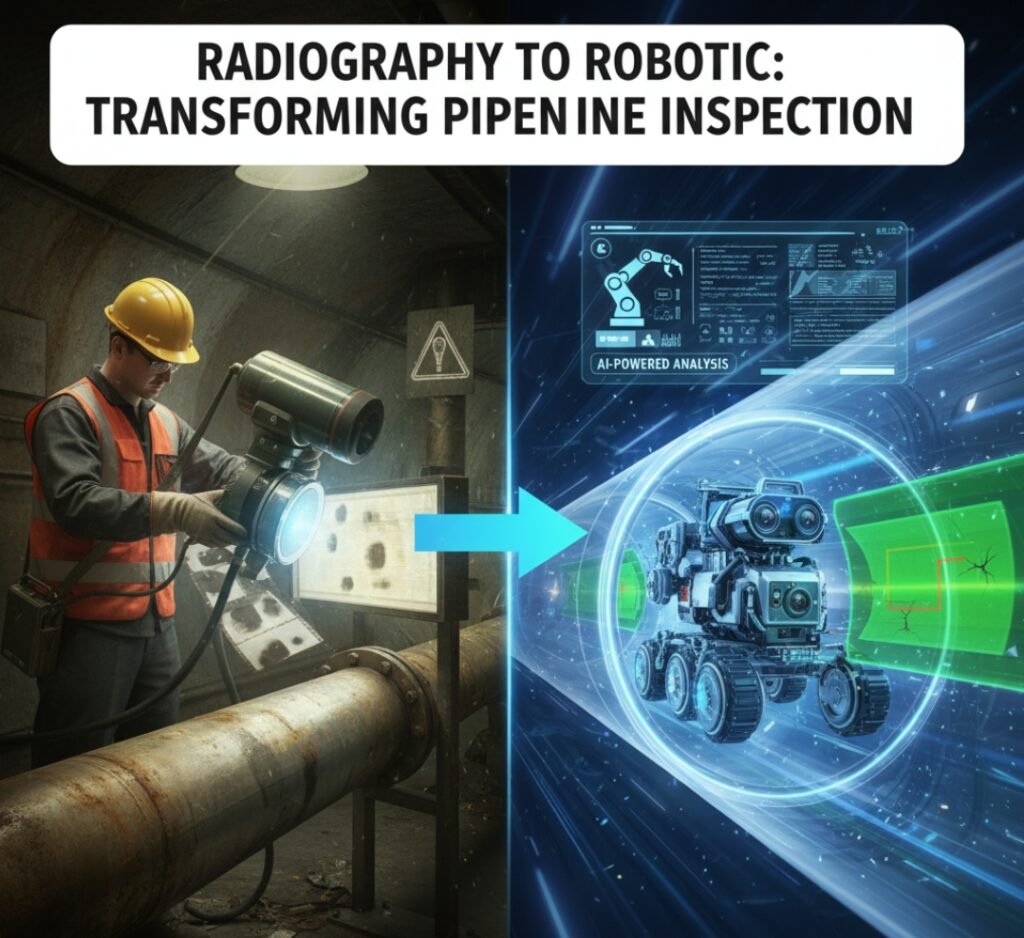If you’ve been around pipeline maintenance and pipe inspection companies for a while, you’ll probably remember the days when radiography was the gold standard. Heavy equipment, radiation safety protocols, long wait times for film development… yeah, it wasn’t exactly the most efficient process. It got the job done, sure, but let’s be honest — it also slowed projects down and sometimes missed the finer details that could make or break the integrity of a pipeline.
Fast-forward to today, and the game has completely changed. We’re now looking at AI-driven robotics crawling, flying, or even swimming their way through inspections. And the difference isn’t just incremental — it’s night and day.
Radiography: The Old Reliable (But Limited)
Radiography earned its place in the industry because it was one of the first technologies that could actually give inspectors a peek inside welds and materials. But it came with baggage.
- Safety concerns: Anytime you deal with radiation, there are serious risks and strict safety rules.
- Downtime: Pipelines often had to be shut down, which meant lost productivity.
- Resolution limits: Smaller cracks, pitting, or early-stage corrosion could slip through unnoticed.
Think of it like taking an X-ray at the doctor’s office. Useful, yes — but compared to today’s MRIs or CT scans, it feels outdated.
Enter Robotics: A Whole New Toolbox
Now, let’s talk robots. Not the Hollywood kind (no Transformers here), but machines specifically designed to handle the harsh, confined, and often dangerous environments inside pipelines. These robots are packed with sensors — ultrasonic, magnetic flux leakage, thermal imaging, you name it — and they can pick up details human inspectors would miss.
Here’s where it gets exciting:
- AI and machine learning: Robots aren’t just collecting data, they’re analyzing it on the spot. They can identify patterns that point to hidden risks before they become catastrophic failures.
- Efficiency: Instead of waiting days for results, operators can get near real-time reports.
- Minimal downtime: Some robotic tools can work while the pipeline stays in service. That’s huge.
In other words, it’s not just faster and safer — it’s smarter.
Why the Shift Matters?
Let’s face it: pipelines are getting older. Many were designed decades ago, and the wear and tear are catching up. Environmental regulations are also tighter than ever, meaning nobody wants to be the fiberglass tank inspection company responsible for the next big leak or spill.
Radiography was fine for its time, but it’s not keeping up with today’s demands. Robotic inspections, powered by AI, offer something radiography never could — predictive insights. Instead of reacting after a problem appears, operators can actually prevent it. And that shift from reactive to proactive? That’s the real game-changer.
But It’s Not All Perfect
Okay, before we get carried away singing the praises of robots, let’s be real. There are still hurdles:
- Upfront costs: Robotic inspections don’t come cheap. The equipment, software, and training can hit budgets hard.
- Learning curve: Engineers and technicians need to get comfortable interpreting new types of data.
- Technology gaps: Not every pipeline environment is robot-friendly yet, especially smaller diameters or complex layouts.
So no, radiography isn’t disappearing tomorrow. But it is being overshadowed by a much more advanced set of tools.
Looking Ahead
Ten years from now, it’s hard to imagine radiography being the go-to method. Robotics, paired with AI, are already proving they can reduce downtime, increase safety, and provide better insights. The shift is happening right in front of us, and operators who adapt early will save money, reduce risks, and frankly, sleep better at night knowing their pipelines are in good shape.
The bottom line? Radiography will probably hang around as a backup, but robotics are taking center stage. And honestly, it’s about time.
FAQs
Q: Is radiography still used in pipeline inspections?
Yes, but its role is shrinking. It’s still useful in certain scenarios, but robotics and advanced NDT tools are replacing it in many cases.
Q: Are robotic inspections safer?
Absolutely. They eliminate radiation risks and reduce the need for human inspectors to enter hazardous environments.
Q: Does this technology work on all pipelines?
Not yet. Some older or smaller pipelines may still be difficult for robotic crawlers, but the tech is improving fast.
Q: Are robotic inspections more expensive?
Upfront, yes. But when you factor in reduced downtime, fewer shutdowns, and avoided leaks or failures, they usually save money long-term.
Q: Will radiography become obsolete?
Not immediately. It still has a role in niche applications, but robotics and AI-driven tools are clearly the future.
Experienced SEO Specialist and Web Developer with a strong focus on off-page SEO and guest posting. With 3 years of proven expertise, I help businesses improve their search rankings and build sustainable online presence.
